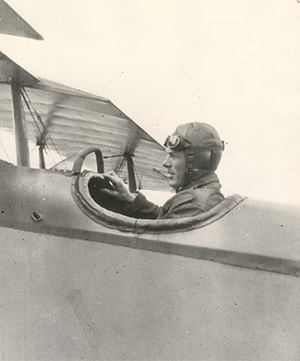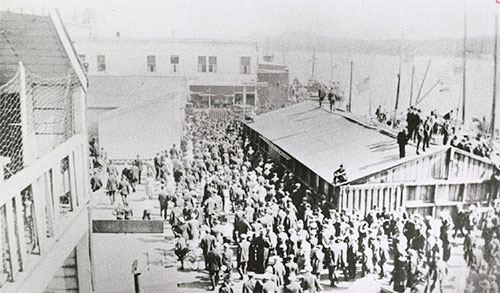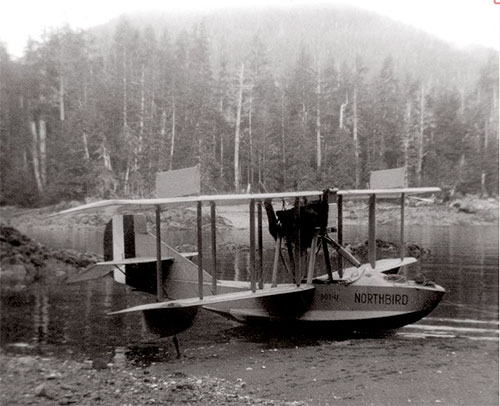Aviation came to Ketchikan a century agoRoy Jones started first commercial aviation company in AlaskaBy DAVE KIFFER July 17, 2022
Planes had flown into and through Alaska before, but Jones' flight from Prince Rupert on July 17, 1922, was the first commercial flight in Alaska. He hoped to start a successful aviation business with his Curtiss Flying Boat, which he had named the Northbird.
It wasn't to be. A crash at Heckman Lake in 1923 proved the end of the Northbird Aviation Company, but Jones lived long enough to see the jet age come to Ketchikan and to take part in the dedication of the Ketchikan International Airport on Gravina Island in 1973. Jones and mechanic Gerald Smith's flight from Seattle to Ketchikan only involved 10 hours of flight time, but took nine days, according to Lone Jansen, writing in the Anchorage based "Great Lander" newsletter n 1981. It involved numerous stops along the British Columbia coast, Jansen wrote. At one point, Jones attempted to take a paying customer aloft, a pulp mill manager looking to scout timber in the area. But Canadian authorities nixed the flight as competition to Canadian boat operators, because the plane was, after all, a flying boat. The final leg, from Prince Rupert, took 90 minutes. Jones had wired friends in Ketchikan letting them know when he planned to arrive. He did not expect a big welcome and was shocked when nearly the entire town of 3,000 people thronged the waterfront to see him fly over, land, and then be brought to shore. There were cheers, speeches and much hullabaloo. Jones may have underestimated his role in changing local transportation forever, but the residents of Ketchikan, hundreds of miles from the nearest large cities, were very aware that something had changed for the community the minute the Northbird touched down in Tongass Narrows. An editorial in the Ketchikan Daily Chronicle the next day, lauded Jones' pioneer "pluck" for leading Ketchikan into the "aerial transportation epoch" noting that while the Northbird was a small plane, it heralded the arrival of much larger planes that would overcome the slow transportation options that limited development in the region. "Only last night, after the arrival of the machine, an attorney talked of wanting to use it to go for a witness needed," the Chronicle opined. "An official talked of returning to his post in the seaplane. Several sportsmen planned on going for an outing, to go fishing. Each of these estimated it would take him a day to go by boat while he could cover the desired ground in an hour or little more by air."
At the time, according to George Beck, who worked for Jones briefly, the Northbird's hanger was near Thomas Basin and the usual fee for a 20-minute flight over Ketchikan was $10 ($173 dollars in 2022). Jones spent the next year giving flight seeing trips but also doing aerial photography and working for fishing and mining companies running workers and equipment to locations throughout Southeast Alaska. He was the first true commercial bush pilot in Alaska. Even after the August, 5, 1923 crash when a sudden downdraft brought down the Northbird at Heckman Lake, Jones tried to keep Northbird Aviation alive, according to Ketchikan aviation historian Don "Bucky" Dawson in a presentation to the Alaska Historical Society in 1987. "Still undaunted, Jones shortly afterward purchased a Boeing pontoon equipped bi-plane from Juneau physician Dr. DeVighne in an effort to keep his charter business alive," Dawson wrote in 1987. But by December of 1923, Dawson wrote, Jones ended up dissolving his business. Jones - staying in Ketchikan and working in construction and as a Prohibition agent - offered to help anyone else who was interested in starting another flying service in Ketchikan.
Eventually Jones sold the Northbird's engine to Russell Merrill who was trying to start up a SE flying service in the mid 1920s before eventually moving on to Anchorage. (See "Russell Merrill's Excellent Southeast Adventure, SITNEWS, August 1, 2017). According to Dawson, in 1929. Jones became the operations manager for Pioneer Airways and then moved to Seattle in 1931, to work for the US Customs Service, where he would stay for the next 24 years, with a brief pause to serve in the Cold Weather Test Detachment of the US Army Air Force in Fairbanks during World War II. He retired from the customs service in 1955. He also retired as a major from the military. Jones was born in Sumas, Washington in 1893. While he was attending the University of Washington, prior to the US entry into World War I, he spent two summers (1915 and 1916) in Southeast waters on US Coast and Geodetic Survey ships. During the War, he learned to fly with the US Army Signal Corps. In 1921, Jones was also a regional salesman in Southeast for Standard Oil. At Standard Oil in Seattle, he met another future big name in Ketchikan aviation history, R.E. "Bob" Ellis. Jones' time in the first city was fairly negligible prior to his 1922 flight, but his wife's family had lived in the First City for a decade.
Jones father-in-law, S.S. "Sam" Kincaid was a prominent Ketchikan resident, the operating engineer of the Citizen's Light and Power powerplant up Ketchikan Creek from downtown Ketchikan. Kincaid had first come to Alaska in 1897 and worked for a while at the Klawock Cannery before he and his wife relocated to Wrangell, where their daughter, Alice, was born. The family had two other daughters as well. The Kincaid family moved to Ketchikan in 1912 when Sam was hired by Citizens Light and Power (the forerunner of Ketchikan Public Utilities). As the power plant operator Kincaid made the facility a popular stop along Ketchikan Creek for the hundreds of visitors to came to Ketchikan in those years. Alice Kincaid graduated from Ketchikan High School in 1916 and then attended the University of Nevada-Reno. She graduated in 1919 and married Roy Jones shortly afterwards. Jones had been visiting Ketchikan earlier, when he and Alice Kincaid met. The Jones' settled in Seattle, and their daughter, Dorothy, was born. But Alice died early in 1922 of peritonitis and Roy decided to relocate to Ketchikan, first taking his daughter to Ketchikan to stay with the Kincaids. While in Ketchikan, Jones also worked to pay for his planned flight from Seattle. According to Dawson, Jones received a $1,500 loan from the Ketchikan Commercial Club (the forerunner of the Chamber of Commerce) and also used $2,200 ($38,200 in 2022 dollars) of his own money to purchase his flying boat. The Curtiss Model F was 27 feet long with a wingspan of 45 feet. It was powered by a 100-horsepower Curtiss engine, that Jones replaced with a similar Hispano-Suiza model, and had a takeoff weight of around 2,400 pounds. It was slow, with a cruising speed of around 65 mph and a range of a bit under 400 miles, so it could stay in the air for about 5 and a half hours. It could fly up to 4.500 feet, high enough to clear most of the mountains in the Ketchikan area. In a later interview, Jones said he often flew toward the top of the plane's range in order to give him "gliding" space in case the Northbird's engine cut out, which it occasionally did during flight. Of course, its main value was that it was a flying boat which meant it could land just about anywhere in Southeast Alaska, which had no real landing sites in those days and only a couple of flat areas safe enough to put a plane down. Jones' father-in-law, Sam Kincaid died of a heart attack in Ketchikan in 1924, at the age of 55 and that year Jones married Grace Chapman, a Ketchikan school teacher, according to a June 1925 article in the Ketchikan Chronicle. Jones also ran for city mayor that year but was unsuccessful against incumbent Thomas Torry. Jones would go on to serve two terms on the Ketchikan City Council in 1927 and 1928. Jones and his wife left Ketchikan in 1931 and by 1940, he was living in Seattle, when he was interviewed by the Chronicle regarding his famous flight 22 years earlier. In that article, Jones took pains to thank the numerous Ketchikan residents who had helped his aviation service during his time in Ketchikan. He also spoke glowingly of the new aircraft that were flying to the Ketchikan area in 1940 and how their engines favorably compared his old Northbird Hispano Suiza engine, which he noted had a bad habit of conking out when the plane was at altitude, causing him much trouble. He noted that he had to have it repaired, and finally replaced, numerous times before the Northbird finally crashed at Heckman Lake in 1923. Over the years, Jones also flew for the US Customs Service, according to Emery Tobin in in a 1973 Ketchikan Daily News article. Jones eventually retired to Vancouver, Washington. He died in 1974, not long after the opening of the Gravina Island airport. Jones, 80, was one of the honored guests at that opening in 1973. A year after Jones died, a mountain on Revillagigedo was named after him. Appropriately, it is close by the earlier named "Northbird" peak.
On the Web:
|
|||||||||






